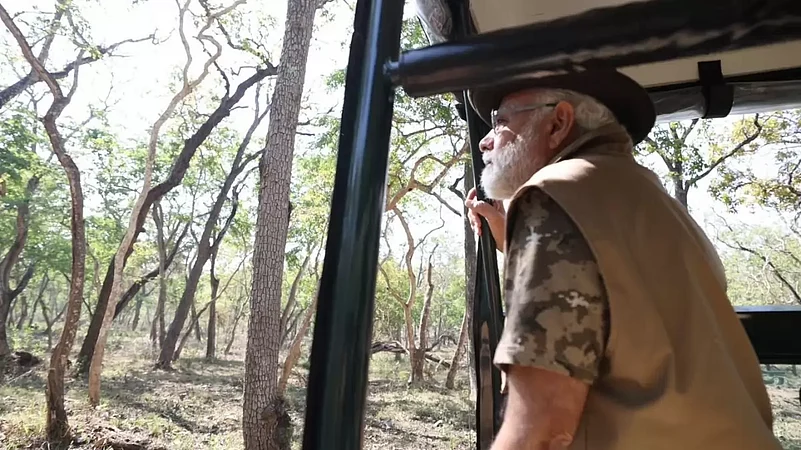Prime Minister Narendra Modi on Sunday released the latest census on tiger conservation and said that as of 2022, India has 3,167 tigers. The tiger numbers were up from 2,967 in 2018 when the last census was released. The tiger population was 1,411 in 2006, 1,706 in 2010, and 2,226 in 2014, according to the data.
Donning a speckled safari clothing and hat, the prime minister took a jungle "safari" today at the Bandipur Tiger Reserve amidst the picturesque surroundings of the towering Western Ghats, between Chamarajanagar and Mysuru districts of poll-bound Karnataka, as part of programmes to commemorate 50 years of ‘Project Tiger'.
On his arrival at the Melukamanahalli helipad, PM Modi travelled by road to Forest Department's reception centre at Bandipur, where he paid respects to a forest martyrs memorial nearby, before leaving for Safari in the forest department's jeep.
Modi reportedly covered about 20-km distance in the open jeep, during the safari ride at the tiger reserve. "Spent the morning at the scenic Bandipur Tiger Reserve and got a glimpse of India’s wildlife, natural beauty and diversity," he tweeted.
He shared pictures of Safari on his Twitter account in which he can be seen standing in the open jeep, and with a camera and binoculars. He also shared pictures of elephants, langurs, spotted deer, and bisons.
On 50 years of Project Tiger’, PM Modi launched the International Big Cats Alliance (IBCA) to focus on the protection and conservation of seven major big cats of the world – tiger, lion, leopard, snow leopard, puma, jaguar and cheetah – with membership of the range countries harbouring these species.
“India has not only saved tigers, but created an ecosystem for them to flourish,” he said. The success of 'Project Tiger', PM said, is a matter of pride not only for India but for the whole world.
Union Minister for Environment, Forest and Climate Change Bhupender Yadav and Minister of State Ashwini Kumar Choubey were present, among others, at the event.
He also visited the Theppakadu Elephant camp in Mudumalai Tiger Reserve in neighbouring Tamil Nadu’s hilly Nilgiris district and interacted with mahouts and 'kavadis' of the elephant camp. He was accorded a welcome by the pachyderms and he fed sugarcane to some of the elephants at the Theppakkadu camp.
What is ‘Project Tiger’?
'Project Tiger', launched on 1 April 1973, aimed to promote tiger conservation. The project initially covered nine tiger reserves spread over 18,278 sq km. At present, there are 53 tiger reserves spanning more than 75,000 sq km (approximately 2.4 per cent of the country's geographical area).
The National Park in Karnataka was formed by including most of the forest areas of the then Venugopala Wildlife Park established under the government notification dated February 19, 1941, and the area was enlarged in 1985 extending over an area of 874.20 sq. km and named Bandipur National Park.
The reserve was brought under 'Project Tiger' in 1973. Subsequently, some adjacent reserve forest areas were added to the reserve extending to 880.02 Sq. Km. The present area under the control of Bandipur Tiger Reserve is 912.04 Sq. Km.
An area of 39.80 sq km of KFDC (Karnataka Forest Development Corporation) plantation area was handed over to this division during 2007-08. During 2010-11, the Nugu Wildlife Sanctuary was handed over to the Wildlife Division, Mysuru, the department said.
Bandipur National Park is an important part of the Nilgiri Biosphere Reserve that constitutes Karnataka’s Rajiv Gandhi National Park (Nagarahole) to its Northwest, Tamil Nadu’s Mudumalai Wildlife Sanctuary to its South, and Kerala’s Wayanad Wildlife Sanctuary to its Southwest.


























